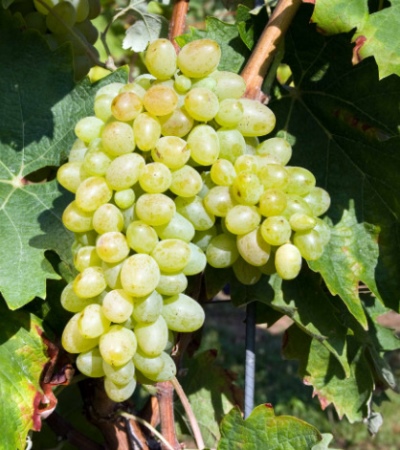
- Authors: Turkey
- Appointment: dining room
- Berry color: yellowish green, sun-tanned
- Taste: moderately sweet, with a peculiar herbaceous flavor
- With bones: Yes
- Ripening period: early
- Ripening period, days: 131
- Frost resistance, ° C: -15
- Name synonyms: Heinovy, Genueser weisser, Fehér tökszőlő, Chaus white, Chaus
- Bunch weight, g: 240-350
The Chaush grape, as the name suggests, was developed in Turkey. But in domestic practice, it can be used quite widely. You just need to properly study the subtleties and nuances of the application, find out how successful the result is.
Breeding history
This table variety appeared in Asia Minor for a very long time. Chaush has been known since at least the 19th century. The specific authorship of the development is unknown, and it is also not established whether targeted selection was once carried out, or this is an accidental luck. Despite its long history, culture still has a certain meaning.
Geography of distribution
The Chaush variety is used in almost all areas of the Crimean Peninsula. It is mainly concentrated, however, in the Alushta region and in the vicinity of Balaklava. It is also grown abroad - in Turkey itself, in Greece, Bulgaria, Romania. There is also information about the cultivation of such grapes throughout the Mediterranean coast. But in other parts of it, it is used much less.
Description
This variety has many synonyms - Chaus, Heinovy, Genuiser weisser, Chaush white, Feger Tökselö, Genueser weisser, Feher tokszolo. The plant is characterized by large and coarse leaves of the five-lobed type. Even in arid areas, the Chaush grape grows strongly, it is distinguished by the early full ripening of the vine. Difficulties may be associated with maintaining optimal thermal conditions and other conditions.
Ripening period
Chaush is an early grape. The approximate ripening period is 131 days. Harvesting usually takes place in the second half of August.
Bunches
Chaush's brushes come in both indefinite and cylindrical-conical shapes. Frequent branching is characteristic. The grapes in the bunch are loosely harvested. The weight of one vine with a harvest reaches 0.24-0.35 kg. The disadvantage is the risk of peas.
Berries
Peculiarities:
yellow-green color;
the presence of seeds (2-3 seeds per 1 grape);
length 2.2-2.5 cm;
width 1.8-2.2 cm;
oval or egg-like;
peel covered with thick prune.
Taste
Chaush is moderately sweet. He has a well-marked herbaceous flavor. The sugar content of the fruit is 150 g / dm³. The tasters gave this variety an assessment of 7 to 8 points.
Yield
The harvest is very decent - it can reach 112 centners per 1 hectare of vineyard. But much depends on the weather conditions and the skill of the winegrowers. Under unfavorable conditions, fertility can drop to 30 centners. There is information that it sometimes rises to 200 centners. Pollination is the decisive factor in many cases.


Growing features
Chaush grapes give 54% of fruiting shoots. On each such shoot, an average of 1.4 vines are formed. The plant needs intensive insolation and decent irrigation. Sandy and sandy loam soils are recommended for planting. It is important that the ground warms up well.
Landing
In the steppe and foothills on the rich land, 2 m is left between the bushes. Ordinary light land implies a gap of 1.75 m. On the skeletal soil of the southern coast of Crimea, the distance is reduced to 1.5 m. The row spacings are standard and always unchanged. Use high enough trellises; planting material is taken strictly from the most productive shoots of fruitful bushes.

Pollination
The pollinating varieties are Shasla and Saperavi. Disembarkation together with them is carried out with a step of 2-3 rows. In case of heavy rains, artificial pollination with pollen of the same varieties is recommended. If not, wild grape pollen can serve as a substitute.
Pruning
The vine should usually be trimmed using a medium technique. With this approach, 6-8 eyes are left. Sometimes a long pruning is carried out, leaving 8-10 eyes. Over time, long pruning is carried out more and more often, because the shoots farthest from the original vine are the most fertile.



Frost resistance and the need for shelter
Chaush grapes can overwinter at temperatures down to -15 degrees. Spring frost resistance is low. Therefore, even in the main areas, covering work is indispensable. In more northern regions, different varieties are needed.

Diseases and pests
Here the situation is as follows:
strong exposure to mildew;
high risk of infection with powdery mildew;
gray mold infection is very likely;
the variety is tolerant to root phylloxera, susceptible to leafy;
specific insect pests are not described, all those that encroach on other varieties are dangerous.

If a grape is exposed to any disease or insect, this always affects its appearance.
Storage
The transportation of the Chaush fruit is almost impossible. Processing the crop into wine or juice is impractical. It is best stored in the refrigerator. In most cases, the entire crop is eaten quickly. In addition to fresh consumption, such grapes can be used for raisins or compote.











































































